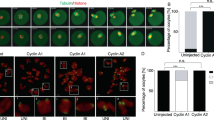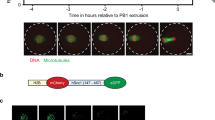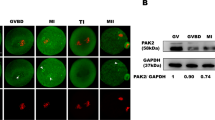Abstract
Here we show that segregation of homologous chromosomes and that of sister chromatids are differentially regulated in Xenopus and possibly in other higher eukaryotes. Upon hormonal stimulation, Xenopus oocytes microinjected with antibodies against the anaphase-promoting complex (APC) activator Fizzy or the APC core subunit Cdc27, or with the checkpoint protein Mad2, a destruction-box peptide or methylated ubiquitin, readily progress through the first meiotic cell cycle and arrest at second meiotic metaphase. However, they fail to segregate sister chromatids and remain arrested at second meiotic metaphase when electrically stimulated or when treated with ionophore A34187, two treatments that mimic fertilization and readily induce chromatid segregation in control oocytes. Thus, APC is required for second meiotic anaphase but not for first meiotic anaphase.
This is a preview of subscription content, access via your institution
Access options
Subscribe to this journal
Receive 12 print issues and online access
$209.00 per year
only $17.42 per issue
Buy this article
- Purchase on Springer Link
- Instant access to full article PDF
Prices may be subject to local taxes which are calculated during checkout




Similar content being viewed by others
References
Zachariae, W. & Nasmyth, K. Genes Dev. 13, 2039–2058 (1999).
Simchen, G. Genetics 76, 745–753 ( 1974).
Salah, S.M. & Nasmyth, K. Chromosoma 109, 27–34 (2000).
Lorca, T. et al. J.C. EMBO J. 17, 3565– 3575 (1998).
Fang, G., Yu, H. & Kirschner, M.W. Genes Dev. 12, 1871– 1883 (1998).
Ohsumi, K., Sawada, W. & Kishimoto, T. J. Cell Sci. 107, 3305– 3013 (1994).
Huang, J. & Raff, J.W. EMBO J. 18, 2184–2195 (1999).
Clute, P. & Pines, J. Nature Cell Biol. 1, 82–87 (1999).
Furuno, H. et al. EMBO J. 13, 2399–2410 (1994).
Galas, S., Barakat, H., Doree, M. & Picard, A. Mol. Biol. Cell 4, 1295–1306 ( 1993).
Kotani, S., Tanaka, H., Yasuda, H. & Todokoro, K. J. Cell Biol. 146, 791–800 ( 1999).
Fisher, D., Coux, O., Bompard-Maréchal, G. & Dorée, M. Biol. Cell 90, 497–508 ( 1998).
Schwab, M., Lutum, A.S. & Seufert, W. Cell 90, 683– 693 (1997).
Visintin, R., Prinz, S. & Amon, A. Science 278, 460– 463 (1997).
Chu, S. et al. Science 282, 699–705 (1998).
Tugendreich, S., Tomkiel, J., Earnshaw, W. & Hieter, P. Cell 81, 261–268 ( 1995).
Zou, H., McGarry, T.J., Bernal, T. & Kirschner, M.W. Science 285, 418–422 ( 1999).
Holloway, S.L., Glotzer, M., King, R.W. & Murray, A.W. Cell 73, 1393–1402 ( 1993).
Lorca, T. et al. Nature 366, 270–273 (1993).
Ciosk, R. et al. Cell 93, 1067–1076 (1998).
Shonn, M.A., McCarroll, R. & Murray, A.W. Science 289, 300– 303 (2000).
Roeder, G.S. Genes Dev. 11, 2600–2621 (1997).
Furuta, T. et al. Mol. Biol. Cell 11 1401– 1419 (2000).
Gerhart, J., Wu, M. & Kirschner, M. J. Cell Biol. 98, 1247– 1255 (1984).
Kobayashi, H. et al. J. Cell Biol. 114, 755– 765 (1991).
Rieder, C.L. & Cole, R. J. Cell Sci. 112, 2607–2613 (1999).
Sumner, A.T. Chromosoma 100, 410–418 (1991).
Minshull, J., Sun, H., Tonks, N.K. & Murray, A.W. Cell 79, 475–486 (1994).
Nicklas, R.B. Phil. Trans. R. Soc. Lond. B 277, 267– 276 (1977).
Labbe, J.C., Picard, A., Karsenti, E. & Doree, M. Dev Biol. 127, 157–169 ( 1988).
Acknowledgements
We are grateful to H. Zou and M. Kirschner for providing the Securin constructs. We thank Pierre Travo, head of the IFR 24 Integrated Imaging Facility for his constant interest and support. This work was supported by grants from the Association pour la Recherche sur le Cancer and the Ligue Nationale contre le Cancer. We apologise to our collegues whose work has not been cited as a result of referencing constraints.
Author information
Authors and Affiliations
Corresponding author
Rights and permissions
About this article
Cite this article
Peter, M., Castro, A., Lorca, T. et al. The APC is dispensable for first meiotic anaphase in Xenopus oocytes . Nat Cell Biol 3, 83–87 (2001). https://doi.org/10.1038/35050607
Received:
Revised:
Accepted:
Published:
Issue Date:
DOI: https://doi.org/10.1038/35050607
This article is cited by
-
Transcriptome profiling of human oocytes experiencing recurrent total fertilization failure
Scientific Reports (2018)
-
Prometaphase APCcdh1 activity prevents non-disjunction in mammalian oocytes
Nature Cell Biology (2007)
-
Histone deacetylase activity is necessary for chromosome condensation during meiotic maturation in Xenopus laevis
Chromosome Research (2006)
-
Cdt1 downregulation by proteolysis and geminin inhibition prevents DNA re-replication in Xenopus
The EMBO Journal (2005)
-
A contractile nuclear actin network drives chromosome congression in oocytes
Nature (2005)



